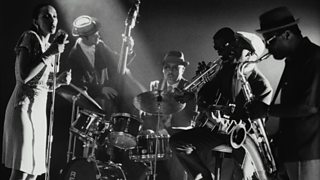4 Styles Of Jazz Music
Popular music styles
Popular music is a general term covering the many different styles and genres of music around since the late 18th Century that are considered to be part of mod everyday culture.
Jazz

Jazz emerged equally a new mode of music in the early twentieth century in the African American communities of New Orleans. Jazz has its origins in dejection and ragtime.
Jazz features lots of improvisation, which requires musicians to:
- creatively explore and experiment with sound
- limited themselves
- listening carefully to themselves and the people they make music with
- answer to the improvisation of people they are playing with
All of this is done spontaneously, with musicians having to react in real time to what is going on around them.
Syncopation is a common characteristic in the rhythm. This is where emphasis is put on rhythms that are off the trounce.
There are many different styles of jazz, eg:
- trad, New Orleans or Dixieland jazz - fashion originating from music played in New Orleans in the early 20th Century
- bebop - mode from the 1940s featuring fast tempo , circuitous harmonies and lots of improvisation
- cool jazz - a more laid back style from the late 1940s
- Latin jazz - jazz featuring rhythms from Latin American music
- jazz fusion - style from the late 1960s that mixes jazz with blues, funk, rock and other styles
The original New Orleans trad jazz style would have typical instrumentation of:
- trumpet or cornet
- trombone
- clarinet
- banjo
- double bass or tuba
- drum kit
The texture in New Orleans, or Dixieland, jazz was very polyphonic and contained lots of improvisation. This means that there were lots of parts weaving in and out of each other.
Trombone glissando - sliding between notes - was a characteristic in this style of jazz and was known as 'tailgate trombone'.
Blues notes
Some notes used in jazz music may be flattened past a semitone. These are normally the third, fifth or seventh notes of the scale.
Musicians playing jazz sometimes use pentatonic scales and blues scales to play improvisations.
Jazz music can exist played past lots of dissimilar types of instruments and by unlike sizes of band. A twenty-piece big band is fabricated up of trumpets, trombones, saxophones, rhythm section and sometimes a vocaliser. A jazz trio often contains a piano or other instrument to play the melody, with double bass and drums providing the rhythm.
Listen to the Soweto Kinch trio - comprising of saxophone, drum kit and double bass - perform the jazz standard 'A Night in Tunisia'.
This rail features improvisation and, although remaining in simple time throughout, alternates from a directly feel to a swing feel. Mind out for when it changes from ane to the other.
4 Styles Of Jazz Music,
Source: https://www.bbc.co.uk/bitesize/guides/z3q47p3/revision/4
Posted by: folsehishey.blogspot.com


0 Response to "4 Styles Of Jazz Music"
Post a Comment